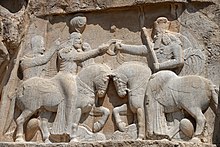

Sasanian art, or Sassanid art, was produced under the Sasanian Empire which ruled from the 3rd to 7th centuries AD, before the Muslim conquest of Persia was completed around 651. In 224 AD, the last Parthian king was defeated by Ardashir I. The resulting Sasanian dynasty would last for four hundred years, ruling modern Iran, Iraq, and much territory to the east and north of modern Iran. At times the Levant, much of Anatolia and parts of Egypt and Arabia were under its control. It began a new era in Iran and Mesopotamia, which in many ways was built on Achaemenid traditions, including the art of the period. Nevertheless, there were also other influences on art of the period that came from as far as China and the Mediterranean.[1]
The surviving art of the Sassanids is best seen in its architecture, reliefs and metalwork, and there are some surviving paintings from what was evidently a widespread production. Stone reliefs were probably greatly outnumbered by interior ones in plaster, of which only fragments have survived. Free standing sculptures are fewer than in Parthian art, but the Colossal Statue of Shapur I (r. AD 240–272) is a major exception, carved from a stalagmite grown in a cave;[2] there are literary mentions of other colossal statues of kings, now lost.[3] There are important Sassanid rock reliefs, and the Parthian tradition of moulded stucco decoration to buildings continued, also including large figurative scenes.[2]

Surviving Sassanid art depicts courtly and chivalric scenes, with considerable grandeur of style, reflecting the lavish life and display of the Sassanid court as recorded by Byzantine ambassadors. Images of rulers dominate many of the surviving works, though none are as large as the Colossal Statue of Shapur I. Hunting and battle scenes enjoyed a special popularity, and lightly-clothed dancing girls and entertainers. Although Parthian art preferred the front view, the narrative representations of the Sassanian art often features figures shown in the profile or a three-quarter view. Frontal views occur less frequently.[2]